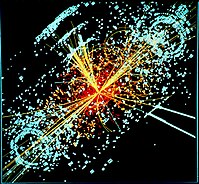
Photo from wikipedia
Inflationary models predicting a scale-dependent large amplification of the density perturbations have recently attracted a lot of attention because the amplified perturbations can seed a sizable amount of primordial black… Click to show full abstract
Inflationary models predicting a scale-dependent large amplification of the density perturbations have recently attracted a lot of attention because the amplified perturbations can seed a sizable amount of primordial black holes (PBHs) and stochastic background of gravitational waves (GWs). While the power spectra in these models are computed based on the linear equation of motion, it is not obvious whether loop corrections are negligible when such a large amplification occurs during inflation. In this paper, as a first step to discuss the loop corrections in such models, we use the in-in formalism and calculate the one-loop scalar power spectrum numerically and analytically in an illustrative model where the density perturbations are resonantly amplified due to oscillatory features in the inflaton potential. Our calculation is technically new in that the amplified perturbations are numerically taken into account in the in-in formalism for the first time. In arriving at our analytical estimates, we highlight the role that the Wronskian condition of perturbations, automatically satisfied in our model, plays in obtaining the correct estimates. In addition, the analytical estimates show that the contribution originating from the quantum nature of the perturbations in the loop can be dominant. We also discuss the necessary conditions for subdominant loop corrections in this model. We find that, for the typical parameter space leading to the 𝒪(107) amplification of the power spectrum required for a sufficient PBH production, the one-loop power spectrum dominates over the tree-level one, indicating the breakdown of the perturbation theory.
Journal Title: Journal of Cosmology and Astroparticle Physics
Year Published: 2022
Link to full text (if available)
Share on Social Media: Sign Up to like & get
recommendations!